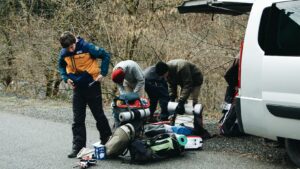Embarking on a hiking adventure can be exhilarating, but it’s also crucial to be prepared. Knowing what to take hiking can make the difference between a memorable outing and a challenging ordeal. This guide will help you pack smart, ensuring you’re ready for anything Mother Nature throws your way.
What To Take Hiking
 When considering what to pack for a hiking trip, it’s critical to prioritize essentials that ensure comfort, safety, and survival. Firstly, navigation tools like a compass and maps are non-negotiable items. They aid in exploring the trail without getting lost. For instance, topographic maps provide detailed terrain features.
When considering what to pack for a hiking trip, it’s critical to prioritize essentials that ensure comfort, safety, and survival. Firstly, navigation tools like a compass and maps are non-negotiable items. They aid in exploring the trail without getting lost. For instance, topographic maps provide detailed terrain features.
Secondly, sun protection, including a brimmed hat, sunglasses, and sunscreen, averts sunburns during hikes. For example, a broad-spectrum sunscreen, with a minimum SPF of 30, is recommended by the American Academy of Dermatology.
Also, insulation elements, such as jackets and gloves, become necessary when tackling colder climates. For instance, insulating layers made of wool or synthetics retain warmth even when wet.
Illumination gear like flashlights or headlamps ensure visibility after dusk. For instance, LED headlamps offer a longer battery life compared to traditional bulb flashlights.
Hydration and Nutrition
 After tackling essentials like navigation tools, sun protection, insulation, lighting, and first-aid supplies, one must underscore the importance of hydration and nutrition on a hiking trip. Adequate water intake, around 2 liters per person per day, safeguards against dehydration. Including a tiny, lightweight water filter can ensure access to clean water, particularly in remote areas.
After tackling essentials like navigation tools, sun protection, insulation, lighting, and first-aid supplies, one must underscore the importance of hydration and nutrition on a hiking trip. Adequate water intake, around 2 liters per person per day, safeguards against dehydration. Including a tiny, lightweight water filter can ensure access to clean water, particularly in remote areas.
As for nutrition, high-energy foods keep the hiker’s stamina up. Consider non-perishable items such as nuts and trail mix, energy bars, dried fruits, and jerky. These are lightweight and take up minimal space. Remember, maintaining energy and hydration levels keeps a hiker active and focused on the trail. You wouldn’t want to find yourself exhausted miles away from your destination, would you? These essentials affirm the role of hydration and nutrition in an enjoyable and worry-free hiking experience.
Choosing the Right Water Containers
Selecting suitable water containers emerges as an essential step while preparing for hiking tours. Eco-friendly and lightweight options like collapsible water bottles reason as an appealing choice. They offer the benefit of economizing space in the backpack once they’re empty. Hydration packs follow suit for their convenience, rendering effortless hydration during the hike. Produced by brands like CamelBak, these feature a water bladder inside the backpack connected via a hose, enabling hikers to drink without stopping.
However, keep in mind the capacity of your container, aiming for at least a two liters’ supply per day, as recommended by Mayo Clinic. For longer hikes or in particularly hot climates, it’s advisable to carry extra water. Bear in mind, though, that water is heavy (around 1 kg per liter) and can add significant weight to your pack, making balance an underlying concern. Stainless steel bottles, while durable and able to keep water cool, might be a tad heavier. Consequently, it’s vital to balance personal hydration needs, carrying capacity, and the weight of the water container.
Weather Protection Items
 Rain or shine, adjusting to the weather on a hiking expedition requires forethought. Waterproof gear, like rain jackets and weather-resistant pants, provide cover in wet climates. Examples include Columbia Rain Slickers and North Face Paramount Trail Convertible Pants. On sunny days, long-sleeve shirts and hats fend off harmful rays, with options like ExOfficio Men’s Air Strip Lite Shirt demonstrating UV ray protection. Furthermore, gloves and warm hats become vital in colder temperatures – Columbia Thermarator Gloves and Smartwool NTS Mid 250 Reversible Headbands align well here.
Rain or shine, adjusting to the weather on a hiking expedition requires forethought. Waterproof gear, like rain jackets and weather-resistant pants, provide cover in wet climates. Examples include Columbia Rain Slickers and North Face Paramount Trail Convertible Pants. On sunny days, long-sleeve shirts and hats fend off harmful rays, with options like ExOfficio Men’s Air Strip Lite Shirt demonstrating UV ray protection. Furthermore, gloves and warm hats become vital in colder temperatures – Columbia Thermarator Gloves and Smartwool NTS Mid 250 Reversible Headbands align well here.
Essential too are emergency shelter equipment such as tents, bivouac sacks, or simple emergency blankets. Notably, these items can turn critical if caught in an unplanned overnight situation. For example, SOL Emergency Blankets offer lightweight, heat-reflective two-sided options. Finally, a good pair of quality hiking boots, like Salomon Men’s Quest 4D 3 GTX Hiking Boots, provide traction and protect feet against water, rocks, and other obstacles.

